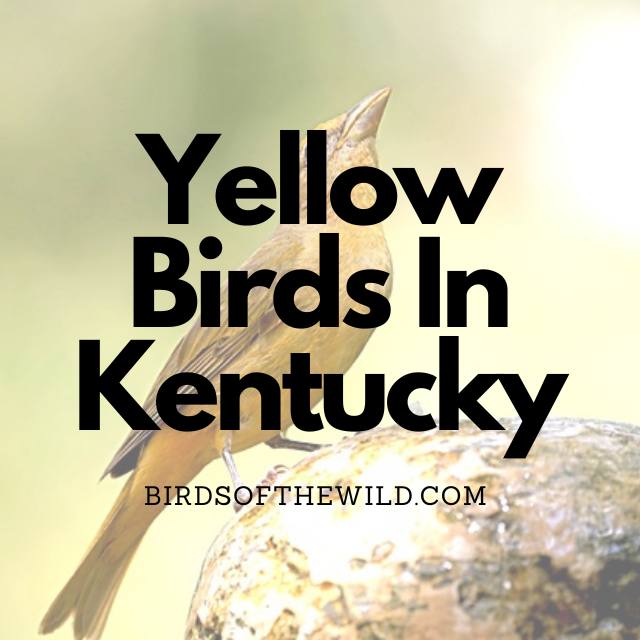In this article I’ll be going over 9 unique yellow birds that can be found across the state of Kentucky so continue reading for a more detailed look at each bird below.
- American Goldfinch
- Baltimore Oriole
- Orchard Oriole
- Yellow Breasted Chat
- Summer Tanager
- Common Yellowthroat
- American Yellow Warbler
- Yellow Rumped Warbler
- Cedar Waxwing
9 Yellow Birds In Kentucky
1. American Goldfinch (Spinus Tristis)

- Size: 11 – 13cm
- Weight: 11 – 20 grams
- Wingspan: 19 – 22cm
American goldfinches are year round residents across all of Kentucky.
These finches are recognised by their yellow, white and black plumage. Their wings are black and white, their forehead is distinguished by the small black patch on it, their under tail is white with the remainder of the body a bright yellow color. Females are far less vibrant with hints of yellow however, are mostly a light brown color.
American goldfinches are found around the edges of forests and plains, around areas filled with brush and thistle plants.
These finches tend to mainly consume seeds that come from the daisy composite family, seeds from weeds, from trees like birches and elm trees, buds, the occasional insect, maple sap, and berries.
American goldfinches are known to live between 2 – 4 years in the wild and upto 9 years in captivity.
2. Baltimore Oriole (Icterus Galbula)

- Size: 15 – 20cm
- Weight: 28 – 43 grams
- Wingspan: 23 – 30cm
Baltimore orioles can be found in all of Kentucky in their spring and summer breeding months.
These orioles are recognised by their orange, black and white plumage, their head and wings that are a black color, their breast and the underside of the tail yellow with a beak that’s black in color. Females are yellow too but, their head isn’t black like the males.
Baltimore orioles can be found within open deciduous woodlands where they will build their nests within American elms, cottonwoods, and maples.
As for the types of food they eat, it includes a variety of small insects like ants, wasps. beetles, grasshoppers, flies among others, flower nectar and smaller fruits like berries. They also feed on sugar water found within feeders.
These orioles are known to live for around 11 years in the wild, which is actually on the longer side for birds of their size.
3. Orchard Oriole (Icterus Spurious)

- Size: 15 – 18cm
- Weight: 16 – 28 grams
- Wingspan: 23 – 27cm
You’ll be able to spot these orchard orioles all across Kentucky when breeding in the spring and summer months.
Orchard orioles are recognised by their orange breast and belly with their neck, head and back black in color. Females on the other hand are almost completely yellow with elements of gray throughout their body.
As for where you can find these birds, they will often be located around semi-open habitats with deciduous trees and open space, including riverside trees, orchards, suburbs, forest edges, forest clearings and prairie groves.
These orioles like most other orioles will consume a number of unique food sources such as insects, nectar from flowers, sugar water from feeders and a number of other smaller berries and fruits.
Orchard orioles can live for around 11 years in the wild.
4. Yellow Breasted Chat (Icteria Virens)

- Size: 17 – 19cm
- Weight: 20 – 34 grams
- Wingspan: 23 – 27cm
These yellow breasted chats are found all throughout Kentucky when breeding. This tends to fall between the spring and summer months.
Yellow breasted chats are recognised by their gray/greenish back, wings and forehead, bright yellow chest and white/grayish underside of their lower half.
These avians like to spend the majority of their time within thickets among other dense grassy environments where bushes, shrubs and clearcuts are present.
As for the type of food these yellow breasted avians eat, they include small insects like bees, wasps, mayflies, grasshoppers, katydids, caterpillars, spiders among others small variants along with the smaller fruits and berries.
Yellow breasted chats also tend to live for around 5 – 8 years in the wild.
5. Summer Tanager (Piranga Rubra)

- Size: 15 – 18cm
- Weight: 25 – 35 grams
- Wingspan: 23 – 28cm
Summer tanagers can be found across the state of Kentucky in their spring and summer breeding months.
Female summer tanagers are small, bright and yellow birds. Their male counterparts are completely red which shows the significant sexual dimorphism between the 2 genders.
You’ll find these birds hanging around open wooded areas, especially in areas with oaks.
As for what these tanagers eat, it includes mostly bees and wasps but they will occasionally go for smaller fruits and berries in bushes or trees.
These little birds are known to live between 3 – 5 years in the wild.
6. Common Yellowthroat (Geothlypis Trichas)
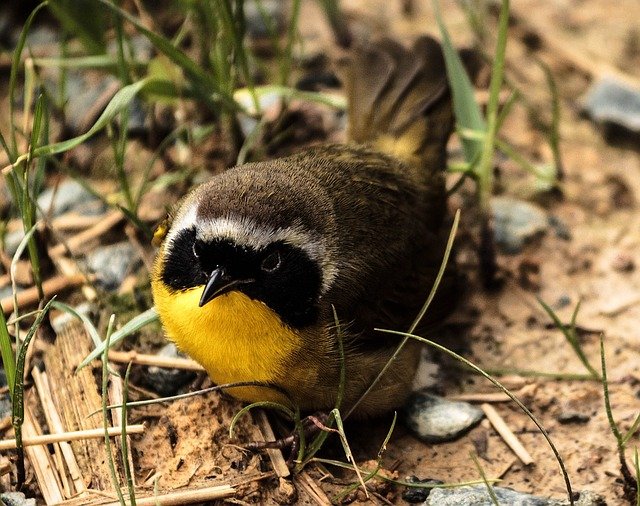
- Size: 11 – 14cm
- Weight: 11 – 15 grams
- Wingspan: 15 – 19cm
You’ll find common yellowthroats in all of Kentucky when they happen to breed.
Common yellowthroats are recognised by their mostly light brown/dirty yellow plumage from their head to tail whilst their throat is a bright yellow color. Females are mostly yellow with small elements of yellow on their tail and chin whilst males have more elements of black on their face.
As for where you can find these yellowthroats, they can be located around swamps, marshes, wet thickets, edges where they will often breed within wet marshes as well. They also nest within briars, moist brushy places, tangles of rank weeds and shrubbery along streams and overgrown fields.
Common yellowthroats are known to eat smaller insects like ants, spiders, and beetles along with seeds and smaller fruits like berries.
These avians can live for around 11 years in the wild.
7. American Yellow Warbler (Setophaga Petechia)
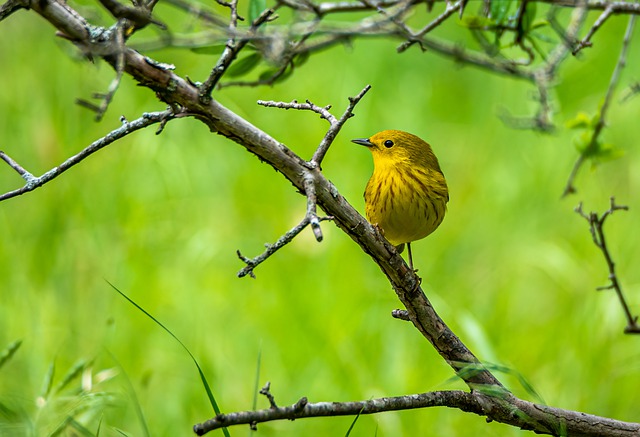
- Size: 12.5 – 13cm
- Weight: 8 – 16 grams
- Wingspan: 16 – 22cm
You’ll find American yellow warblers in Kentucky throughout their breeding spring and summer seasons.
American Yellow Warblers are recognised by their yellow plumage with streaks of brown on their feathers and back. The males have a few more patterns to their plumage but, both the males and females are mostly yellow in color.
As for the habitats in which these little avians tend to spend the majority of their time, it would be bushes, swamp edges, streams, and gardens.
Yellow warblers tend to consume insects and berries with 2/3 of their diet mostly consisting of small insects like caterpillars,
beetles, damselflies, treehoppers, and more.
These little warblers are known to live upto 10 years although most warblers don’t live nearly as long as that. Often a warblers will live closer to 2 – 5 years in the wild as opposed to the full 10.
8. Yellow Rumped Warbler (Setophaga Coronata)
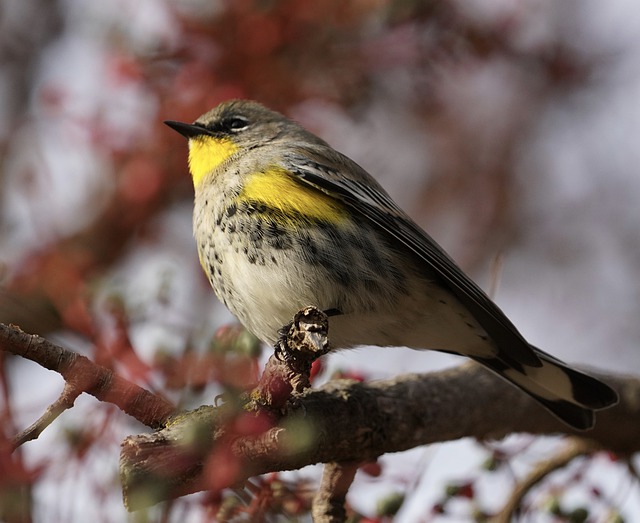
- Size: 12 – 14cm
- Weight: 12 – 13 grams
- Wingspan: 19 – 23cm
Yellow rumped warblers can be found in all of Kentucky in their fall and winter non-breeding months.
These warblers are recognised by their gray and black wings, tail, back, and head with a black mask like stroke across the eye, with yellow elements on the upper end of the wing, on the top and around the upper breast area. Females tend to be a gray/brown color whilst males are a little more vibrant.
Yellow rumped warblers are often found around coniferous forests, especially during the breeding season whilst in winter they can be found in open areas with fruiting shrubs.
As for what they eat, it includes insects and berries where the insects are caterpillars, wasps, grasshoppers, gnats, aphids, beetles, and spiders with the berries including bayberry, juniper, wax myrtle, poison ivy, and others.
Warblers are known to live upto 10 years in the wild.
9. Cedar Waxwing (Bombycilla Cedrorum)
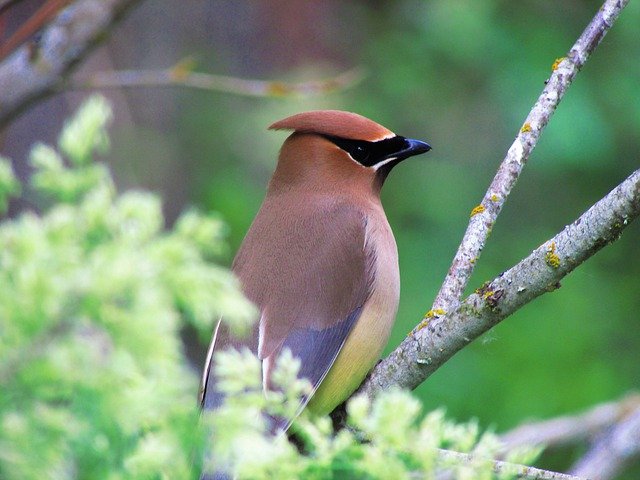
- Size: 15 – 18cm
- Weight: 25 – 35 grams
- Wingspan: 22 – 30cm
Cedar waxwings can be found in western Kentucky in their non-breeding fall and winter months and in the rest of the state on a year round basis.
They’re recognised by their plumage that has elements of yellow across their body which can be found on their tail and breast with the remainder of their body a gradient brownish/gray color, a mask shaped black element on their face and a red strip on their wings. Females look very similar to males with the main tell tail difference being darker coloration on the males chin.
Cedar waxwing can be found around open woodlands, fruiting trees, forest edges, streamsides, overgrown fields, edges of swamps, suburban yards and orchards. In the winter months, they can sometimes be seen spending their time in towns.
These avians are known to mostly eat fruits and berries with the ones they feed on most often being juniper, dogwood, and wild cherries. They also drink the juices from flowers and eat a variety of small insects like beetles, ants, caterpillars etc.
As for their lifespan, they are often known to live for 8 years in the wild.
Amhil Khan, a dedicated nature enthusiast and the founder of BirdsOfTheWild.com, is a passionate advocate for the captivating world of avian wonders. With a deep-seated curiosity about the intricate lives of birds, Amhil’s journey began as a fascination and has evolved into a mission to inspire others to appreciate and protect these magnificent creatures.
Amhil’s love for birds led to the creation of Birds of the Wild, a platform where his expertise in ornithology, coupled with his captivating storytelling, provides readers with an immersive and educational experience. Through his lens and words, he captures the essence of birds in their natural habitats, offering a glimpse into their behaviors, migrations, and the ecosystems they inhabit.

